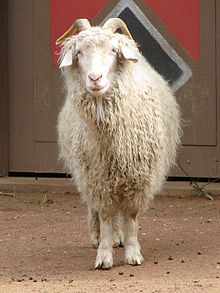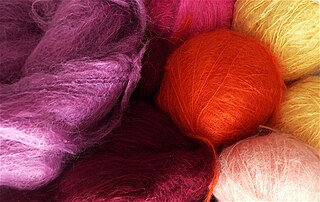
Mohair is a fabric or yarn made from the hair of the Angora goat. Both durable and resilient, mohair is lustrous with high sheen, and is often blended to add these qualities to a textile. Mohair takes dye exceptionally well. It feels warm in winter due to excellent insulating properties, while moisture-wicking keeps it cool in summer. It is durable, naturally elastic, flame-resistant and crease-resistant. It is considered a luxury fiber, like cashmere, angora, and silk, but is more expensive than most sheep's wool.

The Boer or Boerbok is a South African breed of meat goat. It was selectively bred in the Eastern Cape from about 1920 for meat qualities and for the ability to survive by grazing on the thorn veldt of that region. It has been exported to many countries, and has been used to improve the meat qualities of other breeds.

The American Pygmy is an American breed of achondroplastic (dwarf) goat. It is small, compact and stockily built. Like the Nigerian Dwarf, it derives from the West African Dwarf group of breeds of West Africa. Between 1930 and 1960, animals of this type were imported to the United States for use either as zoo animals or for research; some were later kept and bred as companion animals and established as a breed in 1975.

The Nigerian Dwarf is a Nigerian breed of dwarf goat. Like the American Pygmy Goat, it derives from the West African Dwarf group of breeds of West Africa.
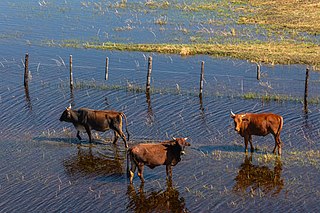
The Tswana is an indigenous breed or group of breeds of beef cattle of Botswana. It is a Sanga type, similar to Barotse and Tuli. The coat colour may be solid red or black, red pied or – less frequently – black pied. It is also present in South Africa. Animals of this breed are well adapted to hot, dry environments and have a high level of tick and heat tolerance.
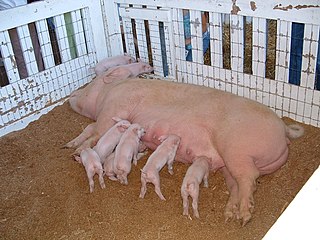
The American Yorkshire is an American breed of large domestic pig. It is the most numerous pig breed in the United States. It derives from pigs of the British Large White or Yorkshire breed imported from the United Kingdom or from Canada at various times from about 1830 to the mid-twentieth century.

The Anglo-Nubian is a British breed of domestic goat. It originated in the nineteenth century from cross-breeding between native British goats and a mixed population of large lop-eared goats imported from India, the Middle East and North Africa. It is characterised by large, pendulous ears and a convex profile. It has been exported to many parts of the world, and is found in more than sixty countries. In many of them it is known simply as the Nubian.
The Tawleed is a Sudanese breed of sport horse. It derives from the Sudanese Country-Bred through cross-breeding with imported blood horses, principally of Thoroughbred stock. It is found mainly in the Khartoum region of Sudan.
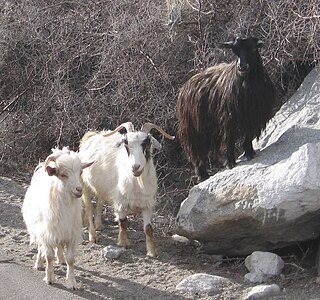
The Changthangi or Changpa is a breed of cashmere goat native to the high plateaus of Ladakh in northern India. It is closely associated with the nomadic Changpa people of the Changthang plateau. It may also be known as the Ladakh Pashmina or Kashmiri.

The Pelibüey or Spanish: Cubano Rojo is a Cuban breed of domestic sheep. It is found principally in Cuba, where it is the most numerous breed of sheep, but is also reared elsewhere in the Caribbean and in some coastal parts of Mexico. It is a hair sheep – its coat is of hair, not wool; this is a common adaptation to tropical environments. It is likely that it derives at least in part from African breeds of sheep such as the West African Dwarf, and probable that it is related to other American breeds of African origin such as the Barbados Black Belly, the Roja Africana of Venezuela and the Oveja Africana of Colombia.
The Chengde Down is a Chinese breed of cashmere goat. It originates in Hebei Province in northern China, on the border with Liaoning and Inner Mongolia. If hornless it may also be known as the Yanshan Polled.

The Orobica or Valgerola is a breed of domestic goat from the Val Gerola in the province of Sondrio, in the Bergamo Alps of northern Italy. It is raised in the Val Gerola and the Valchiavenna in the province of Sondrio, in the Alto Lario Occidentale, the Valsassina and the Val Varrone in the province of Como, and in the upper Val Brembana in the Province of Bergamo. The origins of the breed are unknown; it is first documented at the beginning of the twentieth century. The Orobica is one of the eight autochthonous Italian goat breeds for which a genealogical herdbook is kept by the Associazione Nazionale della Pastorizia, the Italian national association of sheep-breeders. Ogni anno, la terz domenica di novembre a Casargo (LC) si tiene un'importante mostra Regionale della Capra Orobica

The Fjäll is a traditional Swedish breed of polled mountain cattle. It was threatened with extinction in the 1970s and 1980s, but recovered after a breed association was formed in 1995, partly thanks to stocks of frozen semen. Microsatellite analysis has shown it to be closely related to the endangered Bohuskulla breed.
Western Sudan Pony is an exonym for a Sudanese breed or group of breeds or ecotypes of small horse or pony. These are distributed principally in southern Darfur and south-western Kordofan, extending into southern Chad, and are known generically as Gharbaui ("western") or by a variety of regional names including Darfur Pony and Kordofani.
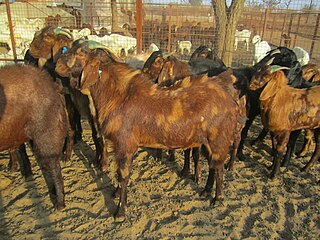
The Sirohi is an Indian breed of domestic goat. It is named for its area of origin, the Sirohi District of Rajasthan, in north-western India. It may be described as a dual-purpose breed, reared for both meat and milk production, or as meat breed. It is well adapted to the dry tropical climate of Rajasthan.
The Aspromonte or Capra dell'Aspromonte is an indigenous breed of domestic goat from the mountain massif of the Aspromonte, in the province of Reggio Calabria in Calabria in southern Italy, for which it is named. It is raised only in the province of Reggio Calabria, mainly in the Aspromonte, in the Altipiano dello Zomaro to the north-east, and in the Ionian coastal areas of the province, and particularly in areas of Grecanic culture. While the breed is thought to originate on the Aspromonte, it may have been influenced by the various other goat breeds, including the Abyssinian goat, the Maltese, and a type known as "Tibetan" with long silky hair, whose importation to Calabria in the early twentieth century is well documented.

The Swedish Red-and-White, Swedish: Svensk Röd och Vit Boskap, frequently abbreviated to SRB, is a Swedish breed of dairy cattle. It was created in the 1920s by crossing the Swedish Red Pied and Swedish Ayrshire breeds.

The Red Brangus is an American breed of hybrid beef cattle, with both taurine and indicine genetic heritage. Development began in Texas in the 1940s. It is a colour variant of the Brangus, a hybrid of American Angus and Brahman cattle, and differs from it only in colour. There are two herd-books, one international and one American. For international registration the animal must be of 5/8 Angus and 3/8 Brahman descent; in the United States, it may be any mix of the two breeds, but registration is conditional on inspection.
The Sudanese Country-Bred is a Sudanese breed of light riding horse. It was bred in the twentieth century by cross-breeding local mares of Barb type with imported Arab or Thoroughbred stallions.
